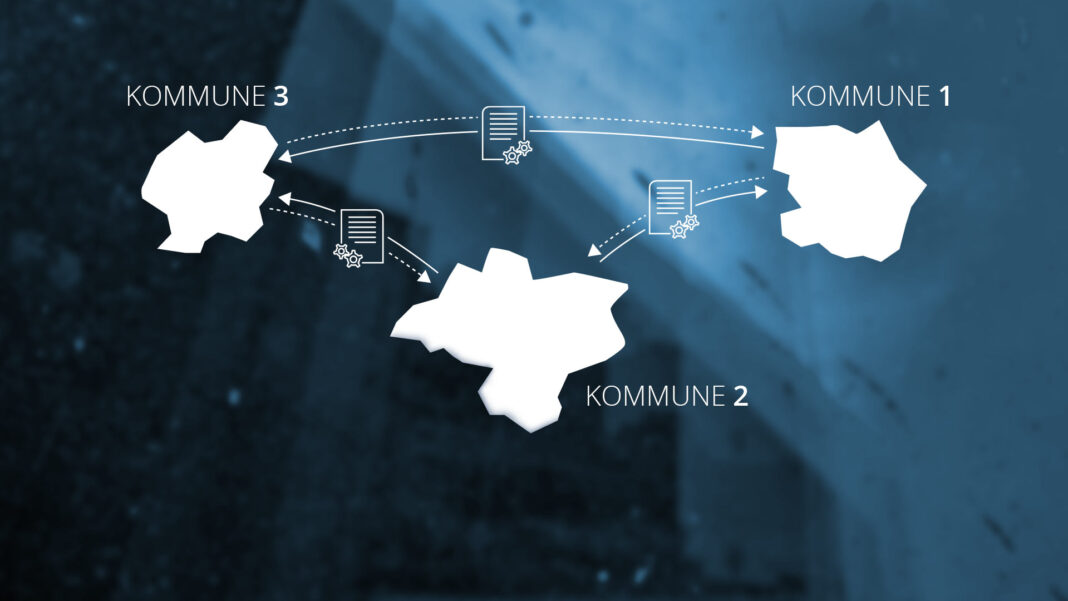The OZG-Cloud stands for a groundbreaking project to advance the digitilization of administration in Germany. Commissioned by the state of Schleswig-Holstein and the IT-Verbund Schleswig-Holstein (ITV.SH) and developed under an open source license, the platform offers municipalities the ability to process applications from online services independently. The advantages: Reduction of workload, collaboration option between individual municipalities, and forwarding of digital applications to specialized procedures. In order to map the technical requirements of over 150 municipalities, the project was developed as a cloud system. The application is developed as an EfA solution and can be used and thus reused throughout Germany. The first pilot projects in other German states have already started.
Short & concise
- Cross-state, cooperative development project based on open source.
- Easy-to-use management software for processing simple applications.
- Cloud system with a very high degree of automation.
- Designed for municipalities in Schleswig-Holstein, interest in adoption from other German states, first pilot projects started.
Between 70 and 80 percent of the OZG services to be implemented are the responsibility of the municipalities. However, there is usually a lack of resources and funding for the creation of corresponding digital structures. In Schleswig-Holstein, municipalities are therefore receiving support from the IT-Verbund Schleswig-Holstein (ITV.SH) in implementing the Online Access Act (in german: Onlinezugangsgesetz, OZG). The search was on for a solution that not only digitizes application processes, but also incorporates the processes within the municipalities.
Digital application processing for municipal administrations
In cooperation with Dataport, the IT service provider for the public administration of Schleswig-Holstein, and mgm as software developer, the “OZG-Cloud” (formerly Kommunales OSI-Plugin) was created. The goal: to offer a simple solution that, on the one hand, makes it possible to maintain municipal self-administration and to let each municipality decide for itself which issues to include. On the other hand, it should be just as easy to provide a digital application for administrative services. In doing so, the municipal challenges of OZG implementation will be addressed, as well as comparable requirements of other public-law institutions and corporations.
The idea is to use existing form solutions to map applications and services in OZG implementations. This is because the OZG cloud is not a specific specialized procedure, but an application that can be used to take application data from various form systems and process it in parts. This enables completely digital processing without media discontinuity. Currently, the solutions are supported by established form services such as intelliForm and Form Solutions, but all providers on the market are possible.
Communication can be handled by linking to a service account – for example, for queries or the delivery of notices. Attachments in PDF format can also be attached in addition to messages to citizens.
Fig.: The OZG Cloud closes the gap in the digitilization of municipalities.
Cloud infrastructure component
The project started in November 2020, and a first prototype was presented in January 2021. Pilot operation with the involvement of municipal users (MVP, Minimal Viable Product) was able to start in September 2021: In the municipality of Nordfriesland, citizens can now apply for a tree felling permit via OZG Cloud and receive the decision. The prerequisite is that they use a service account. In Schleswig-Holstein, this is done via the Online Service Infrastructure (OSI). However, it is also possible to connect the service accounts of other federal states, such as BayernID, and this is already being implemented in initial pilot projects.
Special feature: The additional infrastructure component, namely a self-established cloud in which each municipality receives its own area (namespace). This namespace remains the “territory” of each individual municipality, in which it can, but does not have to, implement a great deal itself in the management of its systems. The cloud system makes it possible to provide clients with a system environment “at the push of a button” and was developed with a very high degree of automation. This applies both to the scaling of technical resources, such as the problem-free addition of further CPU cores or memory, and to the creation and maintenance of new clients. The approach of not mapping the multi-client capability within an application, but rather via namespaces in a cloud, was thus used successfully on a broad scale in public administration for the first time.
Effective collaboration between municipalities
The collaboration options within the municipalities are also new. The application offers a central procedure into which all applications flow, are converted into processes and processed. This makes it possible for several municipalities to collaborate on a technical and organizational level – for example, administrative assistance or vacation replacement. Data remains under the control of the original municipality in compliance with the GDPR. The entire processing of authority procedures can be flexibly adapted to the framework conditions. This means that small municipalities without their own public order office can join forces: The public order office of one municipality is then responsible for all the others. This is possible because a collection of all applications is available on one platform.
Open source project enables continuous further development
The OZG Cloud is a cross-state, cooperative development project based on open source – groundbreaking for administrative digitization in Germany. The use of open source is a paradigm shift and the basis for the project to spread. The source code of the OZG Cloud is openly available. States, municipalities, and manufacturers of forms and specialized procedures can continue to use and expand it. If more federal states join, a community will be created that is constantly evolving like a large open source project.
Where can the OZG Cloud develop further?
More complex processes with a larger workflow cannot (yet) be processed with the OZG Cloud. This is because the standards for the necessary interfaces are often still lacking for forwarding such applications (for example, from social services) to the corresponding specialist process. As soon as the OZG Cloud gains a corresponding reach thanks to its spread to other federal states, it will be worthwhile to build an interface for specialized procedures, which will then become interesting for many municipalities. As a result, the connection of the OZG Cloud also creates added value for the manufacturers of specialized procedures.
In addition, the OZG Cloud in combination with a low-code platform offers further opportunities to exploit the potential in the digitization of administrative processes.
Further information (only in German):
- Website IT-Verbund Schleswig-Holstein: itvsh.de/ozg-cloud
- Brochure: OZG-Cloud








